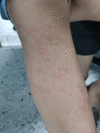It Comes and Goes: Pediatric Chronic Spontaneous Urticaria
- PMID: 37416011
- PMCID: PMC10322213
- DOI: 10.7759/cureus.40006
It Comes and Goes: Pediatric Chronic Spontaneous Urticaria
Abstract
Chronic spontaneous urticaria (CSU) is an underrecognized and underreported condition, even more so in the pediatric population. Due to its fugacious nature, the period between the onset of symptoms and the diagnosis of CSU is often long. We discuss the case of a 10-year-old child who presented with a six-month history of recurrent, pruritic rash. Medical advice was sought on multiple occasions; however, no treatment was initiated. This resulted in the child and caretakers becoming increasingly worried. The child was subsequently diagnosed with CSU. Daily second-generation antihistamine was started, and the child responded well with marked improvement of symptoms. Our case raises a pertinent point. It is crucial for physicians to be able to recognize and treat CSU according to evidence-based guidelines, as this condition may not only negatively affect the child's quality of life, but its impact also extends to the caretakers.
Keywords: antihistamine; chronic spontaneous urticaria; chronic urticaria; omalizumab; pediatric dermatology.
Copyright © 2023, Chin et al.
Conflict of interest statement
The authors have declared that no competing interests exist.
Figures
References
-
- Pediatric chronic spontaneous urticaria: a brief clinician's guide. Votto M, Achilli G, De Filippo M, et al. Expert Rev Clin Immunol. 2022;18:889–899. - PubMed
-
- The international EAACI/GA²LEN/EuroGuiDerm/APAAACI guideline for the definition, classification, diagnosis, and management of urticaria. Zuberbier T, Abdul Latiff AH, Abuzakouk M, et al. Allergy. 2022;77:734–766. - PubMed
Publication types
LinkOut - more resources
Full Text Sources


